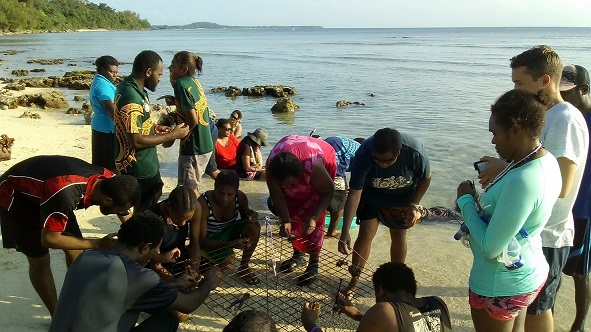

Since 2013, CCCPIR has partnered with local tour operators and bungalow owners to upscale and promote the coral gardening activity. In exchange for a financial sponsorship to the community, incoming international visitors have the opportunity to proactively contribute to adaptation during their stay. Tourists are briefed on the program, learn about climate change and its impacts on coral reefs and then snorkel together with island reef champions to collect the climate resistant coral fragment and attach them on the underwater gardening beds. Specially built coral beds were strategically placed near popular tourism snorkeling areas. The coral beds are in around 6 meters of water, enough to keep them safe from cyclone swells, but shallow enough for tourists to interact with and enjoy. Visitors can come for the day to the island, or, like some school groups from overseas, stay for many weeks planting hundreds of coral fragments.
The visitor adopts each fragment planted, and the money raised goes towards community climate change adaptation activities. The coral becomes part of the “family” and repeat visitors can follow the growth and success of their planted coral colony.
- Strong partnership of NPMLPA network with other stakeholders: such as tour operators, Department of Tourism, international donors, has also been an important factor in aiding sustainability.
- Available tourism infrastructure
- Training and briefing with guests by locals so that they personally feel the value of contributing their time and resources
- Providing a “coral adoption” sponsorship for visitors to formally engage with the program
- It was found that many international visitors feel responsible for climate impacts occurring in the Pacific and are open and willing to participate in adaptation provided these opportunities are available and marketed in a visitor-friendly way by local communities.
- Some tourists cannot swim to the reef beds, and so a shore-based option has been developed whereby fragments are attached by guests to “mini-beds” inn shallow water and then deployed by divers.